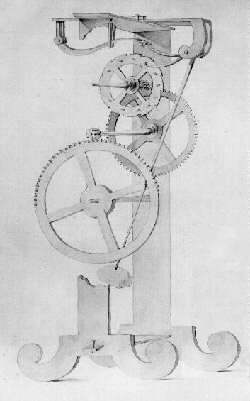
A pendulum clock is a clock that uses a pendulum, a swinging weight, as its timekeeping element. The advantage of a pendulum for timekeeping is that it is an approximate harmonic oscillator: It swings back and forth in a precise time interval dependent on its length, and resists swinging at other rates. From its invention in 1656 by Christiaan Huygens, inspired by Galileo Galilei, until the 1930s, the pendulum clock was the world's most precise timekeeper, accounting for its widespread use. Throughout the 18th and 19th centuries, pendulum clocks in homes, factories, offices, and railroad stations served as primary time standards for scheduling daily life, work shifts, and public transportation. Their greater accuracy allowed for the faster pace of life which was necessary for the Industrial Revolution. The home pendulum clock was replaced by less-expensive synchronous electric clocks in the 1930s and '40s. Pendulum clocks are now kept mostly for their decorative and antique value.

A clock face is the part of an analog clock that displays time through the use of a flat dial with reference marks, and revolving pointers turning on concentric shafts at the center, called hands. In its most basic, globally recognized form, the periphery of the dial is numbered 1 through 12 indicating the hours in a 12-hour cycle, and a short hour hand makes two revolutions in a day. A long minute hand makes one revolution every hour. The face may also include a second hand, which makes one revolution per minute. The term is less commonly used for the time display on digital clocks and watches.

The Prague astronomical clock or Prague Orloj is a medieval astronomical clock attached to the Old Town Hall in Prague, the capital of the Czech Republic.
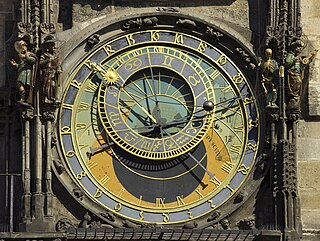
An astronomical clock, horologium, or orloj is a clock with special mechanisms and dials to display astronomical information, such as the relative positions of the Sun, Moon, zodiacal constellations, and sometimes major planets.

The vergeescapement is the earliest known type of mechanical escapement, the mechanism in a mechanical clock that controls its rate by allowing the gear train to advance at regular intervals or 'ticks'. Verge escapements were used from the late 13th century until the mid 19th century in clocks and pocketwatches. The name verge comes from the Latin virga, meaning stick or rod.

The Zytglogge is a landmark medieval tower in Bern, Switzerland. Built in the early 13th century, it has served the city as a guard tower, prison, clock tower, centre of urban life and civic memorial.

A striking clock is a clock that sounds the hours audibly on a bell, gong, or other audible device. In 12-hour striking, used most commonly in striking clocks today, the clock strikes once at 1:00 am, twice at 2:00 am, continuing in this way up to twelve times at 12:00 mid-day, then starts again, striking once at 1:00 pm, twice at 2:00 pm, up to twelve times at 12:00 midnight.

The Clock Tower in Venice is an early Renaissance building on the north side of the Piazza San Marco, at the entrance to the Merceria. It comprises a tower, which contains the clock, and lower buildings on each side. It adjoins the eastern end of the Procuratie Vecchie. Both the tower and the clock date from the last decade of the 15th century, though the mechanism of the clock has subsequently been much altered. It was placed where the clock would be visible from the waters of the lagoon and give notice to everyone of the wealth and glory of Venice. The lower two floors of the tower make a monumental archway into the main street of the city, the Merceria, which linked the political and religious centre with the commercial and financial centre. Today it is one of the 11 venues managed by the Fondazione Musei Civici di Venezia.

The Salisbury Cathedral clock is a large iron-framed tower clock without a dial, in Salisbury Cathedral, England. Thought to date from about 1386, it is a well-preserved example of the earliest type of mechanical clock, called verge and foliot clocks, and is said to be the oldest working clock in the world, although similar claims are made for other clocks. Previously in a bell-tower which was demolished in 1790, the clock was restored to working condition in 1956 and is on display in the North nave aisle of the cathedral, close to the West front.

The Wells Cathedral clock is an astronomical clock in the north transept of Wells Cathedral, England. The clock is one of the group of famous 14th– to 16th–century astronomical clocks to be found in the West of England. The surviving mechanism, dated to between 1386 and 1392, was replaced in the 19th century, and was eventually moved to the Science Museum in London, where it continues to operate. The dial represents the geocentric view of the universe, with the Sun and Moon revolving round a central fixed Earth. It may be unique in showing a philosophical model of the pre-Copernican universe.

A turret clock or tower clock is a clock designed to be mounted high in the wall of a building, usually in a clock tower, in public buildings such as churches, university buildings, and town halls. As a public amenity to enable the community to tell the time, it has a large face visible from far away, and often a striking mechanism which rings bells upon the hours.

The history of timekeeping devices dates back to when ancient civilizations first observed astronomical bodies as they moved across the sky. Devices and methods for keeping time have gradually improved through a series of new inventions, starting with measuring time by continuous processes, such as the flow of liquid in water clocks, to mechanical clocks, and eventually repetitive, oscillatory processes, such as the swing of pendulums. Oscillating timekeepers are used in all modern timepieces.
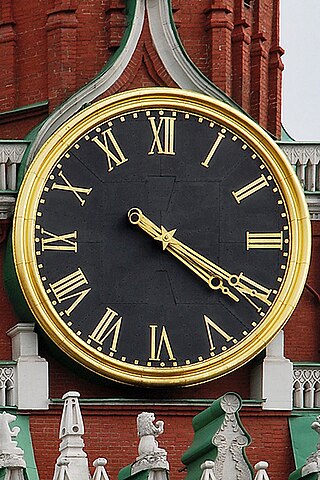
The Kremlin Clock or Kremlin Chimes, also known colloquially in the West as Moscow Clock Tower, is a historic clock on the Spasskaya Tower of Moscow Kremlin. The clock dial is above the main gates to Red Square. For decades, the chimes have rung on the quarter-hour, with bells tolling for each full hour.
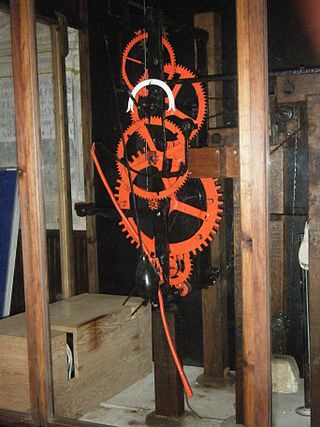
The Castle Combe clock in St. Andrew's Church, Castle Combe, Wiltshire, England was probably made in the late 15th century. It is faceless and strikes a bell in the church tower.
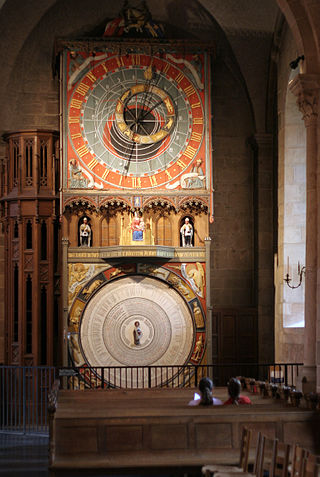
Lund astronomical clock, occasionally and at least since the 16th century referred to as Horologium mirabile Lundense, is a 15th-century astronomical clock in Lund Cathedral. Mentioned in written sources for the first time in 1442, it was probably made and installed sometime around 1423–1425, possibly by Nikolaus Lilienfeld. It is part of a group of related medieval astronomical clocks found in the area around the south Baltic Sea. In 1837 the clock was dismantled. Between 1909 and 1923, it was restored by the Danish clockmaker Julius Bertram-Larsen and the Swedish architect responsible for the upkeep of the cathedral, Theodor Wåhlin. From the old clock, the face of the clock as well as the mechanism, which was largely replaced during the 18th century, was salvaged and re-used. The casing, most parts of the calendar which occupies the lower part, and the middle section were made anew.
David Robertson was the first Professor of Electrical Engineering at Bristol University. Robertson had wide interests and one of these was horology – he wanted to provide the foundation of what we could call “horological engineering”, that is, a firm science-based approach to the design of accurate mechanical clocks. He contributed a long series on the scientific foundations of precision clocks to the Horological Journal which was the main publication for the trade in the UK; he and his students undertook research on clocks and pendulums ; and he designed at least one notable clock, to keep University time and control the chiming of Great George in the Wills Memorial Building from its inauguration on 1925, for which he also designed the chiming mechanism.
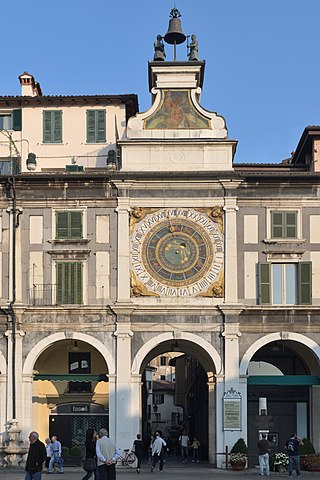
The Torre dell'Orologio is a 16th-century building located in the Piazza della Loggia in Brescia, northern Italy.

The Torre dell'Orologio is a 15th-century renaissance tower on the Piazza delle Erbe in Mantua, Italy. It is attached to the Palazzo della Ragione, and next to the Rotonda di San Lorenzo. It houses an astronomical clock.

The Münster astronomical clock is an astronomical clock in Münster Cathedral in Münster, Germany.
The Bourges astronomical clock is an astronomical clock in Bourges Cathedral in Bourges, France.





















